Running from horizon to horizon, highly polished rails shimmer in the morning sun. It is quiet, but then the rails start to quiver and reverberate . . . the air suddenly moves . . . a sucking sound. . . and WHOOSH.’! Four hundred tons of metal blitz by. As quick as it came it’s gone, the vibrating overhead wires twitching and resonating with an alien sound are the only trace of its passing.
The sheer exhilaration of seeing a high- speed train flat out at maximum speed is astonishing. Human senses are not prepared to take in a massive train rocketing along the ground at 3 miles a minute or faster. What was that? Where did it come from? Where was it going? How fast was it moving? What makes it work? Where can I get on?!
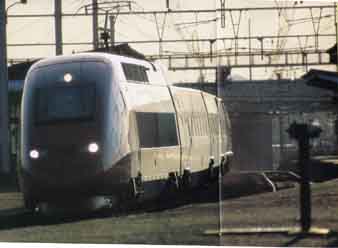
A Paris-to-Köln Thalys glides through
Schaarbeek station in Brussels. The Thlays service,
which connects cities in France, Belgium, Netherlands,
end Germany, employs a specialized fleet of Trains a
Grande Vitesse [TGVs] designed to work off a variety of voltages and
different cab signaling systems.
This history, development, and application of high-speed trains around the world is a fascinating story.
Magic Numbers
We may deny it, but some numbers have greater meaning to us than others. Take the year 2000: What made it special? There seemed far more interest in the coming of the new millennium than the approach of any other year in memory. Speed thresholds are viewed in the same way. Fast trains are often described in terms of their top speed. So what’s so special about a train going 186 miles per hour? Why not 185 or 187 miles per hour? It’s simple: 186 miles per hour is the same as 300 kilometers per hour, a number with special significance for high speed trains since most countries that operate high-speed trains use the metric system, measuring distance in kilometers instead of miles. Pushing the limits of steel wheel technology, various railways have tried to break the 400- kilometer per hour and 500-kilometer per hour thresholds. Converted to mere miles per hour, these high speeds seem less significant.
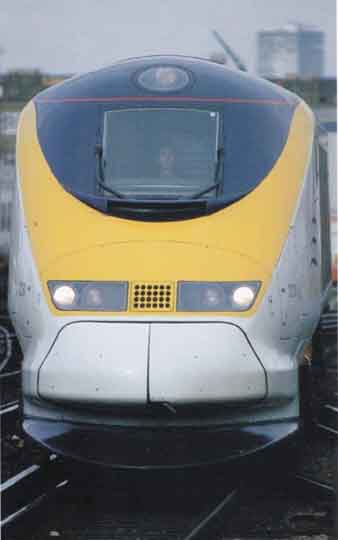
A Eurostar train rolls toward the Channel Tunnel a few minutes
after departing Waterloo International in London.
The Eurostar is an adaptation of the successful French TGV high-speed
technology.
How Fast Is Fast?
To the uninformed observer, a mile-long freight train traveling at 60 miles per hour might seem fast. How about an Amtrak passenger train whizzing by at 79 miles per hour? Those speeds may have seemed quick at the turn of the last century, but as far as modern railway technology is concerned 79 miles per hour is just the restricted speed applied to a train leaving the station! Generally speaking, the trains in this web site can travel at a maximum speed of at least 125 miles per hour, which happens to be 200 kilometers per hour, a nice, even magic number. Incidentally, all of the high-speed railways highlighted in this web site use conventional steel wheel-on-steel rail technology, not magnetic levitation. As of this writing, emerging Mag-Lev technology has not yet been applied to any significant commercial transportation corridor, although both Japan and Germany have considered Mag-Lev for selected routes.
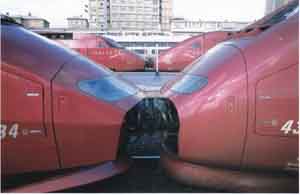
Two sets of coupled Thalys TGVs wait for passengers at Gare
du Nord in Paris. Paris-Brussels-Koln and Paris-Brussels-Amsterdam Thalys
sets are often coupled and run as a single train as far as Brussels.
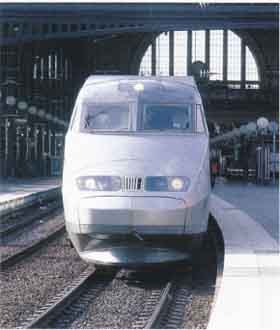
Gare du Nord in Paris is a primary terminal for international
TGV services between France and England, Belgium, Germany, and the Netherlands.
An SNCF TGV Réseau set prepares to depart Gare du Nord on February 24, 1
999.
Diversity
Each major high-speed rail system has developed using different design criteria. As a result, there is considerable technological diversity in the different systems. We will look at why one system uses electric locomotives and others opt for a multiple-unit or “distributed power” system. With a multiple-unit configuration (MU) there is no conventional locomotive or “power car” semi-permanently coupled to its train. Instead, traction motors power the axles that are spread through out the train. Often the locomotive and train are designed to operate together in a fixed train set, exhibiting a continuous, streamlined style. The traditional operating arrangement, whereby train length is adjusted to match demand, is often dispensed with when semi-permanently coupled train sets are used. Most modern high-speed trains are double ended, which means there is a cab with operator controls at both ends of the train set. The train is designed to operate in both directions. It doesn’t require turning or special treatment at terminals. Some high-speed trains use power cars at both ends, while others use a push-pull arrangement with a single power car at one end of the train and an engineer’s control cab at the other.
The highest speeds are obtained on exclusive tracks specially designed for high-speed operation. These are typically grade-separated routes—meaning there are no level crossings with either roads or other railways—and they feature long tangents (straight sections) with gentle curves. The specific parameters of different high-speed lines are as varied as the trains that operate on them.

The French TGV has become the most popular high-speed train
in Europe. Today TGVs serve dozens of cities in France and neighboring countries
in Europe. A pair of 1981 vintage TGV Paris-Sud Est (PSE) sets pause for
passengers at Dijon, France. Traditionally the TGV PSE sets were painted
in an orange-brown-and-white livery. This has gradually given way to the
more modern gray-silver-and-blue scheme seen on these trains.
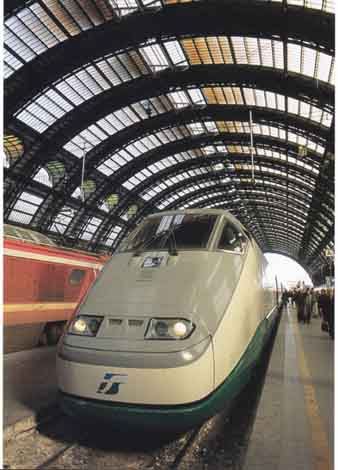
Italy’s fastest train, the ETP500, provides a premier passenger
service between major Italian cities. An ETR500 basks in the glow of the
noontime sun beneath the massive train shed at Milano Centrale [Milan Central].
Some high-speed trains employ a tilting technology to provide a more comfortable ride at high speeds by reducing the effects of centrifugal forces on passengers when passing through curves. This also allows a tilting train to run much faster on curving track than conventional, non-tilting trains. Typically, tilting trains are used to provide faster rail service over existing routes. This is a cost compromise, since it’s much cheaper to implement than build a new high- speed infrastructure.
Why High Speed?
What are the advantages of high-speed rail? Why have the most progressive and technologically advanced nations in the world spent billions of dollars developing high-speed railways? High-speed rail offers one of the fastest, most efficient, and most comfortable ways to travel over moderate distances between city centers. That high-speed rail is simply the best transportation alternative for such routes was first demonstrated in Japan in the 1960s and in France in the 1980s, where new high-speed rail lines quickly dominated transportation markets, reducing highway and air travel. Compared to automobiles and air travel, high-speed rail uses the least amount of energy and resources per person moved. It offers travelers a quick, relaxing way to reach their destinations. They avoid highway congestion and anxiety or having to make their way to and from airports—often many miles from city centers— and having to deal with complex airport check-in procedures.
One of the most impressive trains in the world, France’s TGV provides a fast, comfortable transportation alternative to air travel. The TGV is vastly superior to intercity automobile travel.
Last, high-speed rail is one of the world’s safest modes of travel. The Japanese and French high-speed systems have carried millions of passengers a year without any major fatal accidents. You are less likely to be injured while riding a high-speed train than on virtually any other form of transportation. Unfortunately, a couple of recent, highly publicized accidents with high- speed trains in Germany and Britain have marred a nearly perfect travel record. These tragic accidents are anomalies and do not reflect the extremely safe conditions of rail travel. The British publication Steel Wheels pointed out that British railways have historically been one of the safest modes of travel and illustrated this with a memorable statistic: In 1998 alone there were more highway fatalities in Britain than rail way passenger fatalities in the entire 17 history of British railways! This is an especially significant statistic because the modern railway originated in Britain in the early 19th century. The country has maintained high passenger usage since.
Fast trains have enjoyed an enormous growth in popularity. High-speed rail lines are under construction in many countries around the world. In 2001, the United States, which has operated 125-mile per hour trains for years, was expected to join the list of countries running trains at the 150-mile per hour mark with the introduction of Ace/a Express service in the Northeast Corridor.

A TGV PSE train catches the glint of the rising sun as it rolls
into Gare de Lyon in Paris. The traditional TGV PSE trains have eight passenger
cars spliced between two high-horsepower power cars.
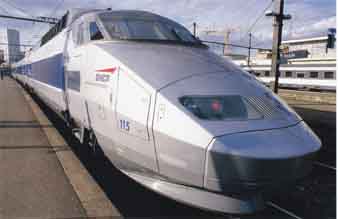
The classic lines of TGV PSE reflect French aesthetic attitudes.
In addition to high performance, the TGV must look good as well. When the
TGV was introduced in 1981 it was the fastest regularly scheduled train
in the world.
<< Prev. Next: American
High-Speed Trains and Rail >>
Top of Page